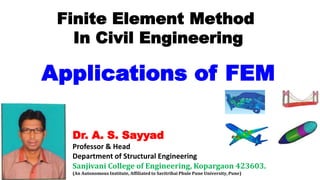Lect04
- 1. Dr. A. S. Sayyad Professor & Head Department of Structural Engineering Sanjivani College of Engineering, Kopargaon 423603. (An Autonomous Institute, Affiliated to Savitribai Phule Pune University, Pune) Finite Element Method In Civil Engineering Applications of FEM
- 2. Applications of FEM Finite Element Method Solid Mechanics Fluid Mechanics Electrical Problems Heat Transfer Joint displacements /Kinematic unknowns Velocity Electric and Magnetic Field Temperature
- 3. Civil Engineering: 1. Analysis of bars, trusses, beams, frames and grids 2. Earthquake analysis of structures 3. Analysis of bridges, dams, retaining walls and water tanks 4. Bending, buckling and vibration analysis of beams, plates and shells. Applications of FEM Mechanical Engineering: 1. Analysis of pressure vessels, flywheels, gears, fluid flow, wave propagation problems 2. IC engines, turbines, blades, steam pipes, nozzles 3. Analysis of casting, forming, welding and machining process.
- 4. Aerospace Engineering: 1. Bending, buckling and vibration analysis of aircrafts, rockets, missiles, spacecraft 2. Transient analysis of aircraft and spacecraft Applications of FEM Medical: 1. Stress analysis of bones and teeth 2. Mechanics of heart valves Electrical Engineering: 1. Analysis of electromechanical devices such as motors, actuators 2. Eddy current and core losses in electric machines



